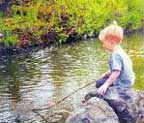
Vol. II, No. 4, May 2003
Nature Buffers Children's Life Stress
A substantial amount of research and literature has documented the positive effects of the natural environment on the well-being of adults. Time spent in or viewing nature has been show to contribute to better psychological well-being, superior cognitive functioning, fewer physical ailments, and speedier recovery from illness. One research study has even shown that viewing street trees on the commute to and from work has a positive impact on family well-being.
Although it is widely accepted that that the natural environment is likely to have an even more profound effect on children due to their greater vulnerability and plasticity, there has been limited research, especially on nature's impact on children's well-being.
 Numerous
studies have demonstrated children's preference for the outdoors. Other research
on the impact of nature on children has shown that 5-year olds who have little
opportunity for unsupervised play outdoors have poorer social, behavior and
motor skills than children with easy access to the outdoors. Another study
found that children attending an "outdoors in all weather" day care
surrounded by natural environments had better motor coordination and greater
attention capacity than did children in an urban day care center surrounded
by only tall buildings. Research has shown that children who have moved and
experienced an increase in their exposure to nature have higher levels of
cognitive functioning compared to children who experienced less increase after
a move. Activities in nature have been shown to lower the symptoms of children
who suffer from Attention Deficit Disorder (ADD). One study found a direct
correlation between girls' ability to concentrate, have self control and delay
gratification based upon the degree of naturalness of views from their homes.
Numerous
studies have demonstrated children's preference for the outdoors. Other research
on the impact of nature on children has shown that 5-year olds who have little
opportunity for unsupervised play outdoors have poorer social, behavior and
motor skills than children with easy access to the outdoors. Another study
found that children attending an "outdoors in all weather" day care
surrounded by natural environments had better motor coordination and greater
attention capacity than did children in an urban day care center surrounded
by only tall buildings. Research has shown that children who have moved and
experienced an increase in their exposure to nature have higher levels of
cognitive functioning compared to children who experienced less increase after
a move. Activities in nature have been shown to lower the symptoms of children
who suffer from Attention Deficit Disorder (ADD). One study found a direct
correlation between girls' ability to concentrate, have self control and delay
gratification based upon the degree of naturalness of views from their homes.
Together, the research suggests that not only do children prefer to spend time in nature, but also that lack of contact with natural environments negatively affects their well-being. Now a new research study of children Grades 3 - 5 (Wells, N., & Evans, G., 2003, Nearby Nature, A Buffer of Life Stress Among Rural Children, Environment & Behavior, 35, 311-330) has found that the amount of nearby nature moderates the impact of stressful life events on the psychological well-being of children and improves their self-worth. This research found that the impact of life stress was lowest and the self-worth highest among children with the highest levels of nearby nature compared with children with little nearby nature. To state it differently, the study found that nature moderates the impact of stressful life events such as relocation, being picked on or punished in school and peer pressure on the self-worth of children.
The researchers point out that the finding that children with a high degree of exposure to nature seem to be protected from the impact of life's stresses has important implications and relevancy in urban settings for low income and impoverished children. If access to nature is indeed a protective factor, contributing to the resilience of children, then if nature is lacking in the daily lives of poor, urban children, which is usually is, than that it is just one more strike against poor children who already face tremendous disadvantages.
The concept that nature moderates and protects children from the brunt of life stresses has important implications for policy and design, since natural areas near and in housing, child care and school settings are essential features needed to foster the resilience of children and promote their healthy development. Currently, few states have any requirements in their child care licensing requirements for naturalized playgrounds; nor do NAEYC accreditation standards or Head Start standards. Children in Head Start programs are often the most at risk children and subject to the most stressful lives. This new research clearly shows that the early childhood community needs to take a hard look at modifying its design standards and practices to better meet the needs of young children.
For years, our company has been advocating and designing naturalized playgrounds
for clients. To help shift the paradigm of playground design, we call these
outdoor play and learning environments discovery play gardens so
the emphasis is on nature rather than on manufactured equipment. It is refreshing
for us to find that research has now substantiated the importance of incorporating
nature into the environments such as child care where many children spend
the majority of their waking hours.

